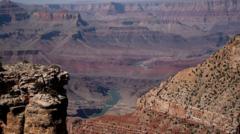Are Wildfires in Arizona Forcing Evacuations Near the Grand Canyon?

The Impact of Wildfires on National Parks: A Closer Look at Recent Events
Wildfires are an increasing concern across various regions in the United States, particularly during the summer months when conditions become ripe for such disasters. Recently, the White Sage Fire near the Grand Canyon National Park in Arizona has drawn attention due to its rapid expansion and the subsequent evacuation orders for nearby residents. This article explores the causes, effects, and emergency responses associated with wildfires, highlighting the importance of preparedness and safety measures in protecting both human lives and natural resources.
Understanding the Causes of Wildfires
Wildfires can be ignited by natural causes, human activities, or a combination of both. Understanding these causes is essential for developing effective prevention strategies.
Natural Causes
- Lightning Strikes: One of the most common natural causes of wildfires, lightning can ignite dry vegetation and lead to rapid fire spread.
- Drought Conditions: Extended periods of low precipitation create dry vegetation, making it easier for fires to ignite and spread.
- High Winds: Wind can carry embers to new locations, helping to spread the fire quickly.
Human Activities
- Campfires: Unattended or improperly extinguished campfires can easily ignite surrounding vegetation.
- Discarded Cigarettes: A common cause of wildfires, discarded cigarettes can smolder for hours before igniting surrounding materials.
- Equipment Use: Sparks from machinery or vehicles can ignite dry brush and cause fires to start.
The White Sage Fire: A Case Study
The White Sage Fire, ignited by lightning on July 9, has exemplified the devastating impact of wildfires. Spanning approximately 1,000 acres near Jacob Lake, the fire has forced the closure of the North Rim of the Grand Canyon National Park and triggered evacuation orders for local residents.
Current Status of the Fire
As of the latest reports, the White Sage Fire remains 0% contained, with emergency responders actively battling the blaze using both ground and air strategies. High temperatures, gusty winds, and low humidity have exacerbated the situation, creating a perfect storm for rapid fire spread. The park officials have reported that the fire's progression toward Jacob Lake necessitated immediate evacuation orders for all visitors at the North Rim.
Emergency Response Efforts
The response to the wildfire includes a coordinated effort by various agencies, utilizing fire retardants and firefighting crews to combat the flames. The Arizona Department of Transportation has also closed portions of State Route 89A to ensure public safety and manage traffic as evacuation orders are enacted.
The Broader Impact of Wildfires
While the White Sage Fire is currently a focal point, wildfires pose a broader threat across the western United States. The evacuation of Black Canyon of the Gunnison National Park in Colorado, approximately 260 miles southwest of Denver, illustrates that wildfire threats are not confined to a single area. Multiple wildfires, caused by lightning, are currently being managed across the region, highlighting the widespread nature of this issue.
Environmental Effects
Wildfires can lead to significant environmental consequences, including:
- Destruction of Habitat: Fires can destroy the homes of countless species, affecting biodiversity.
- Soil Erosion: With vegetation removed, soil becomes more susceptible to erosion, leading to further ecological imbalance.
- Air Quality Issues: Smoke from wildfires can lead to poor air quality, affecting human health and contributing to climate change.
Economic Consequences
The economic impact of wildfires is also substantial. Tourism can be significantly affected as national parks close their doors to visitors, leading to loss of revenue for local businesses. The costs associated with firefighting efforts, damage repairs, and restoration can also strain governmental budgets.
Preparedness and Safety Measures
Given the increasing frequency and intensity of wildfires, preparedness is crucial for both individuals and communities. Here are some essential safety measures:
For Residents and Visitors
- Stay Informed: Keep track of local news and follow park alerts regarding fire conditions and evacuation orders.
- Create a Safety Plan: Develop an emergency plan that includes evacuation routes and communication strategies with family and friends.
- Prepare an Emergency Kit: Include essential items such as water, food, medications, and important documents.
For Homeowners
- Defensible Space: Create a defensible space around your home by clearing flammable materials and maintaining landscaping.
- Fire-Resistant Materials: Use fire-resistant building materials for roofing and siding to reduce fire risk.
- Regular Maintenance: Maintain gutters, vents, and roofs to prevent the accumulation of debris that could catch fire.
The Role of Climate Change in Wildfires
Climate change has been identified as a significant factor contributing to the frequency and severity of wildfires. Rising temperatures, prolonged droughts, and changing weather patterns create conditions conducive to fire ignition and spread. Understanding this relationship is essential for developing long-term strategies to mitigate fire risks.
Adapting to a Changing Environment
Communities must adapt to these changing conditions by implementing sustainable practices, such as:
- Forest Management: Thinning and controlled burns can help reduce fuel loads in fire-prone areas.
- Land Use Planning: Implementing zoning laws that consider fire risk can prevent development in high-risk areas.
- Community Engagement: Educating residents about fire risks and safety measures can foster a culture of preparedness.
Conclusion
The White Sage Fire serves as a stark reminder of the dangers posed by wildfires, not only in Arizona but across the nation. As climate change continues to affect weather patterns and vegetation, the risk of wildfires will likely increase. It is crucial for individuals, communities, and policymakers to take proactive steps to prepare for and mitigate the impact of these disasters. By understanding the causes, effects, and necessary safety measures, we can better protect ourselves, our communities, and the natural beauty of our national parks.
Frequently Asked Questions
What should I do if I am in an area affected by a wildfire?
If you are in an area affected by a wildfire, it is essential to follow evacuation orders from local authorities. Stay informed through reliable news sources and park alerts. Have an emergency kit ready and make sure you have a plan for communication with family and friends.
How can I help wildfire victims?
You can help wildfire victims by donating to relief organizations that provide support to affected communities. Additionally, volunteer efforts to assist in recovery and rebuilding can make a significant impact.
What are the signs of a wildfire approaching?
Signs of an approaching wildfire include unusual smells of smoke, a sudden change in wind direction, or seeing flames or smoke in the distance. If you notice any of these signs, prepare for evacuation and stay informed through local alerts.
As we face these challenges, we must work together to protect our communities and the environment. How prepared are you for potential wildfires in your area? #WildfireSafety #EmergencyPreparedness #ClimateChange
Published: 2025-07-11 13:09:40 | Category: technology



